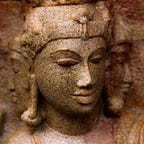Mud Mortar Technique in Ancient Poompuhar
Poompuhar the celebrated port of the Early Cholas in the Tamil Country was one of the leading ports at the beginning of the “Common Era”. The word Puhar in Tamil stands for a place where a river enters a Sea.
Poompuhar is the place where the Kaveri joins the Bay of Bengal. This city is described in glowing terms in Tamil literary works like the Silapathikaram and Manimekalai. Puhar was an important Buddhist centre from 2nd Century BCE onwards.
Buddha Vihara
The site of Buddha Vihara (1600 years old) at Pallavanisvaram of Kaveripoompattinam (Poompuhar) was excavated by the Archaeological Survey of lndia and it is proved that it formed part of old Poompuhar.
This ancient Buddha Vihara was built with well burnt bricks of various sizes and the binding substance was only Mud Mortar. The size of the bricks used for the basement were 36.25 x 18.75 x 7.5 cm whereas the size of the bricks used for the superstructure were 23.75x 12.5 x 5 cm.
Analysis of 1,600 year old Mud Mortar used in Buddha Vihara at Pallavanisvaram in Ancient Poompuhar. Research on Ancient Mud Mortar mix used in Buddha Vihara is necessary to find out the Chief Ingredients in the Mortar-Mix for their stability even after 1,600 years.
Mortar is used to bind together the stone or bricks of the walls of a superstructure to provide smooth hard surface. What is required for mortar is obviously some substance that will harden and adhere strongly to brick or stone for putting these materials together in a structure.
Mud Mortar was used in Buddha Vihara as binding substance. Mud consists of Clay, Silt & Sand. Smallest particles in the soil have dimension less than 0.002mm. It is nothing but Minerals having different composition. They are Albite, Quartz, Illite, Montmorillonite & Kaolinite.
All are Silicates. Due to the action of Aluminium Oxide & Iron Oxide with H2O become Slushy. On drying they cement together like a rock due to combination of Aluminium & Iron with silicate group in the centre forming layers of Tetrahedral & Octahedral (4&8 Molecules of H20) rings.
The detailed analysis of the Ancient Mud Mortar (1,600 years old) used in Buddha Vihara showed that fine fibrous materials (PANDANUS — SPECIES) தாழை நார் had been used as the Chief Ingredient for binding besides Sand and Jaggery.
The analysis showed that with the ageing of the Buddha Vihara. The sugary taste of the sucrose is lessened but not the binding capacity! Thanks.
